Progressive Failure Characteristics of Brittle Rock under High-Strain-Rate Compression Using the Bonded Particle Model
Abstract
:1. Introduction
2. Materials and Methods
3. Results
3.1. Case of the Intact Sample
3.2. Case of the Sample Containing An Open Flaw
4. Discussion
5. Conclusions
Author Contributions
Funding
Conflicts of Interest
References
- Zhang, Q.B.; Zhao, J. A review of dynamic experimental techniques and mechanical behaviour of rock materials. Rock Mech. Rock Eng. 2014, 47, 1411–1478. [Google Scholar] [CrossRef] [Green Version]
- Zou, C.; Wong, L.N.Y.; Loo, J.J.; Gan, B.S. Different mechanical and cracking behaviors of single-flawed brittle gypsum specimens under dynamic and quasi-static loadings. Eng. Geol. 2016, 201, 71–84. [Google Scholar] [CrossRef]
- Dai, F.; Xia, K. Loading rate dependence of tensile strength anisotropy of barre granite. Pure Appl. Geophys. 2010, 167, 1419–1432. [Google Scholar] [CrossRef]
- Dai, F.; Huang, S.; Xia, K.; Tan, Z. Some fundamental issues in dynamic compression and tension tests of rocks using split hopkinson pressure bar. Rock Mech. Rock Eng. 2010, 43, 657–666. [Google Scholar] [CrossRef]
- Huang, S.; Xia, K.; Yan, F.; Feng, X. An experimental study of the rate dependence of tensile strength softening of longyou sandstone. Rock Mech. Rock Eng. 2010, 43, 677–683. [Google Scholar] [CrossRef]
- Wang, R.; Hu, Z.; Zhang, D.; Wang, Q. Propagation of the stress wave through the filled joint with linear viscoelastic deformation behavior using time-domain recursive method. Rock Mech. Rock Eng. 2017, 50, 3197–3207. [Google Scholar] [CrossRef]
- Li, X.B.; Lok, T.S.; Zhao, J. Dynamic characteristics of granite subjected to intermediate loading rate. Rock Mech. Rock Eng. 2005, 38, 21–39. [Google Scholar] [CrossRef]
- Xia, K.; Nasseri, M.H.B.; Mohanty, B.; Lu, F.; Chen, R.; Luo, S.N. Effects of microstructures on dynamic compression of barre granite. Int. J. Rock Mech. Min. Sci. 2008, 45, 879–887. [Google Scholar] [CrossRef]
- Goodman, R.E. Methods of Geological Engineering in Discontinuous Rocks; West Pubublishing Company: Eagan, MN, USA, 1976. [Google Scholar]
- Sun, G.Z. Rock Mass Structure Mechanics; Science Press: Beijing, China, 1988. (in Chinese) [Google Scholar]
- Wong, L.N.Y.; Einstein, H.H. Crack coalescence in molded gypsum and carrara marble: Part 1. Macroscopic observations and interpretation. Rock Mech. Rock Eng. 2009, 42, 475–511. [Google Scholar] [CrossRef]
- Wong, L.N.Y.; Einstein, H.H. Crack coalescence in molded gypsum and carrara marble: Part 2—microscopic observations and interpretation. Rock Mech. Rock Eng. 2009, 42, 513–545. [Google Scholar] [CrossRef]
- Bobet, A.; Einstein, H.H. Fracture coalescence in rock-type materials under uniaxial and biaxial compression. Int. J. Rock Mech. Min. Sci. 1998, 35, 863–888. [Google Scholar] [CrossRef]
- Horii, H.; Nemat-Nasser, S. Compression-induced microcrack growth in brittle solids: Axial splitting and shear failure. J. Geophys. Res. 1985, 90, 3105–3125. [Google Scholar] [CrossRef]
- Wong, L.N.Y.; Einstein, H.H. Systematic evaluation of cracking behavior in specimens containing single flaws under uniaxial compression. Int. J. Rock Mech. Min. Sci. 2009, 46, 239–249. [Google Scholar] [CrossRef]
- Chen, R.; Xia, K.; Dai, F.; Lu, F.; Luo, S.N. Determination of dynamic fracture parameters using a semi-circular bend technique in split hopkinson pressure bar testing. Eng. Fract. Mech. 2009, 76, 1268–1276. [Google Scholar] [CrossRef]
- Xia, K.; Huang, S.; Dai, F. Evaluation of the frictional effect in dynamic notched semi-circular bend tests. Int. J. Rock Mech. Min. Sci. 2013, 62, 148–151. [Google Scholar] [CrossRef]
- Huang, X.; Qi, S.; Xia, K.; Shi, X. Particle crushing of a filled fracture during compression and its effect on stress wave propagation. J. Geophys. Res. Solid Earth 2018, 123, 5559–5587. [Google Scholar] [CrossRef]
- Li, X.; Zhou, T.; Li, D. Dynamic strength and fracturing behavior of single-flawed prismatic marble specimens under impact loading with a split-hopkinson pressure bar. Rock Mech. Rock Eng. 2017, 50, 29–44. [Google Scholar] [CrossRef]
- Zou, C.; Wong, L.N.Y. Experimental studies on cracking processes and failure in marble under dynamic loading. Eng. Geol. 2014, 173, 19–31. [Google Scholar] [CrossRef]
- Cai, M.; Kaiser, P.K. In-situ rock spalling strength near excavation boundaries. Rock Mech. Rock Eng. 2014, 47, 659–675. [Google Scholar] [CrossRef]
- Guo, S.; Qi, S. Numerical study on progressive failure of hard rock samples with an unfilled undulate joint. Eng. Geol. 2015, 193, 173–182. [Google Scholar] [CrossRef]
- Guo, S.; Qi, S.; Cai, M. Influence of tunnel wall roughness and localized stress concentrations on the initiation of brittle spalling. Bull. Eng. Geol. Environ. 2015, 75, 1597–1607. [Google Scholar] [CrossRef]
- Guo, S.; Qi, S.; Zhan, Z.; Zheng, B. Plastic-strain-dependent strength model to simulate the cracking process of brittle rocks with an existing non-persistent joint. Eng. Geol. 2017, 231, 114–125. [Google Scholar] [CrossRef]
- Martin, C.D. Seventeenth canadian geotechnical colloquium: The effect of cohesion loss and stress path on brittle rock strength. Can. Geotech. J. 1997, 34, 698–725. [Google Scholar] [CrossRef]
- Martin, C.D.; Chandler, N.A. The progressive fracture of lac du bonnet granite. Int. J. Rock Mech. Min. 1994, 31, 643–659. [Google Scholar] [CrossRef]
- Martini, C.D.; Read, R.S.; Martino, J.B. Observations of brittle failure around a circular test tunnel. Int. J. Rock Mech. Min. Sci. 1997, 34, 1065–1073. [Google Scholar] [CrossRef]
- Reches, Z.; Lockner, D.A. Nucleation and growth of faults in brittle rocks. J. Geophys. Res. Solid Earth 1994, 99, 18159–18173. [Google Scholar] [CrossRef]
- Cho, N.; Martin, C.D.; Sego, D.C. A clumped particle model for rock. Int. J. Rock Mech. Min. Sci. 2007, 44, 997–1010. [Google Scholar] [CrossRef]
- Fakhimi, A. Application of slightly overlapped circular particles assembly in numerical simulation of rocks with high friction angles. Eng. Geol. 2004, 74, 129–138. [Google Scholar] [CrossRef]
- Hazzard, J.F.; Young, R.P.; Maxwell, S.C. Micromechanical modeling of cracking and failure in brittle rocks. J. Geophys. Res. Solid Earth 2000, 105, 16683–16697. [Google Scholar] [CrossRef]
- Potyondy, D.O.; Cundall, P.A. A bonded-particle model for rock. Int. J. Rock Mech. Min. Sci. 2004, 41, 1329–1364. [Google Scholar] [CrossRef]
- Potyondy, D.O. Simulating stress corrosion with a bonded-particle model for rock. Int. J. Rock Mech. Min. Sci. 2007, 44, 677–691. [Google Scholar] [CrossRef]
- Xia, M.; Zhou, K.P. Particle simulation of the failure process of brittle rock under triaxial compression. Int. J. Miner. Metall. Mater. 2010, 17, 507–513. [Google Scholar] [CrossRef]
- Wong, L.N.Y.; Zhang, X.P. Size effects on cracking behavior of flaw-containing specimens under compressive loading. Rock Mech. Rock Eng. 2014, 47, 1921–1930. [Google Scholar] [CrossRef]
- Zhang, X.P.; Wong, L.N.Y. Cracking processes in rock-like material containing a single flaw under uniaxial compression: A numerical study based on parallel bonded-particle model approach. Rock Mech. Rock Eng. 2012, 45, 711–737. [Google Scholar] [CrossRef]
- Zhang, X.P.; Wong, L.N.Y. Crack initiation, propagation and coalescence in rock-like material containing two flaws: A numerical study based on bonded-particle model approach. Rock Mech. Rock Eng. 2013, 46, 1001–1021. [Google Scholar] [CrossRef]
- Li, X.F.; Zhang, Q.B.; Li, H.B.; Zhao, J. Grain-based discrete element method (gb-dem) modelling of multi-scale fracturing in rocks under dynamic loading. Rock Mech. Rock Eng. 2018, 51, 3785–3817. [Google Scholar] [CrossRef]
- Du, H.B.; Dai, F.; Xu, Y.; Liu, Y.; Xu, H.N. Numerical investigation on the dynamic strength and failure behavior of rocks under hydrostatic confinement in SHPB testing. Int. J. Rock Mech. Min. Sci. 2018, 108, 43–57. [Google Scholar] [CrossRef]
- Li, X.B.; Zou, Y.; Zhou, Z.L. Numerical simulation of the rock shpb test with a special shape striker based on the discrete element method. Rock Mech. Rock Eng. 2014, 47, 1693–1709. [Google Scholar] [CrossRef]
- Gui, Y.L.; Bui, H.H.; Kodikara, J.; Zhang, Q.B.; Zhao, J.; Rabczuk, T. Modelling the dynamic failure of brittle rocks using a hybrid continuum-discrete element method with a mixed-mode cohesive fracture model. Int. J. Impact Eng. 2016, 87, 146–155. [Google Scholar] [CrossRef]
- Du, H.; Dai, F.; Xia, K.; Xu, N.; Xu, Y. Numerical investigation on the dynamic progressive fracture mechanism of cracked chevron notched semi-circular bend specimens in split hopkinson pressure bar tests. Eng. Fract. Mech. 2017, 184, 202–217. [Google Scholar] [CrossRef]
- Xu, Y.; Dai, F.; Xu, N.W.; Zhao, T. Numerical investigation of dynamic rock fracture toughness determination using a semi-circular bend specimen in split hopkinson pressure bar testing. Rock Mech. Rock Eng. 2015, 49, 731–745. [Google Scholar] [CrossRef]
- Dai, F.; Xu, Y.; Zhao, T.; Xu, N.W.; Liu, Y. Loading-rate-dependent progressive fracturing of cracked chevron-notched brazilian disc specimens in split hopkinson pressure bar tests. Int. J. Rock Mech. Min. Sci. 2016, 88, 49–60. [Google Scholar] [CrossRef]
- Huang, X.; Qi, S.; Williams, A.; Zou, Y.; Zheng, B. Numerical simulation of stress wave propagating through filled joints by particle model. Int. J. Solids Struct. 2015, 69–70, 23–33. [Google Scholar] [CrossRef]
- Itasca. PFC2D Particle Flow Code in 2 Dimensions, 3.1 ed.; Itasca: Minneapolis, MN, USA, 2004. [Google Scholar]
- Nara, Y.; Kashiwaya, K.; Nishida, Y.; Ii, T. Influence of surrounding environment on subcritical crack growth in marble. Tectonophysics 2017, 706–707, 116–128. [Google Scholar] [CrossRef] [Green Version]
- Resende, R.; Lamas, L.N.; Lemos, J.V.; Calçada, R. Micromechanical modelling of stress waves in rock and rock fractures. Rock Mech. Rock Eng. 2010, 43, 741–761. [Google Scholar] [CrossRef]
- Huang, X.; Qi, S.; Yao, W.; Xia, K. Effect of filling humidity on the propagation of high-amplitude stress waves through an artificial joint. Geotech. Test. J. 2019, 42, 20170192. [Google Scholar]
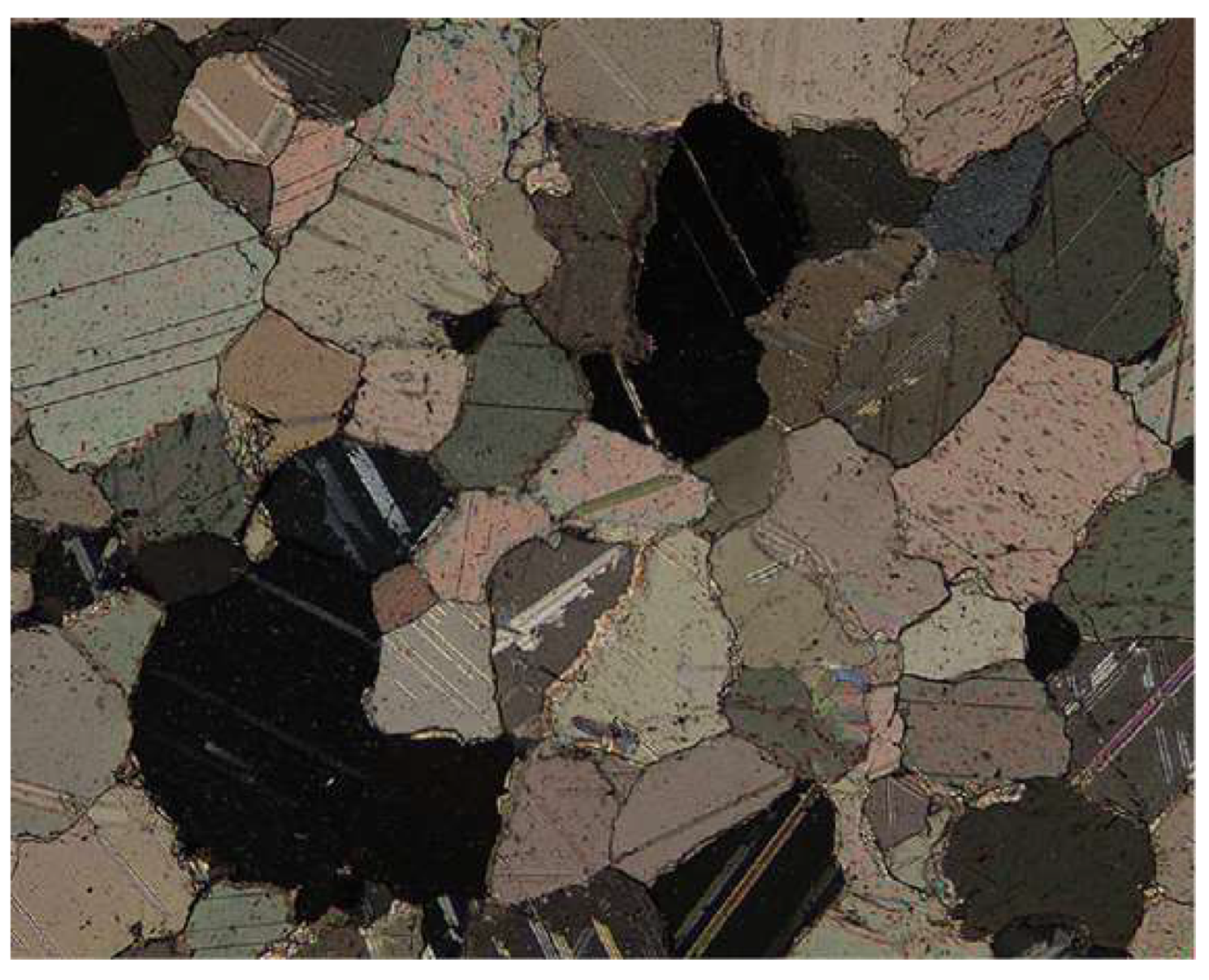
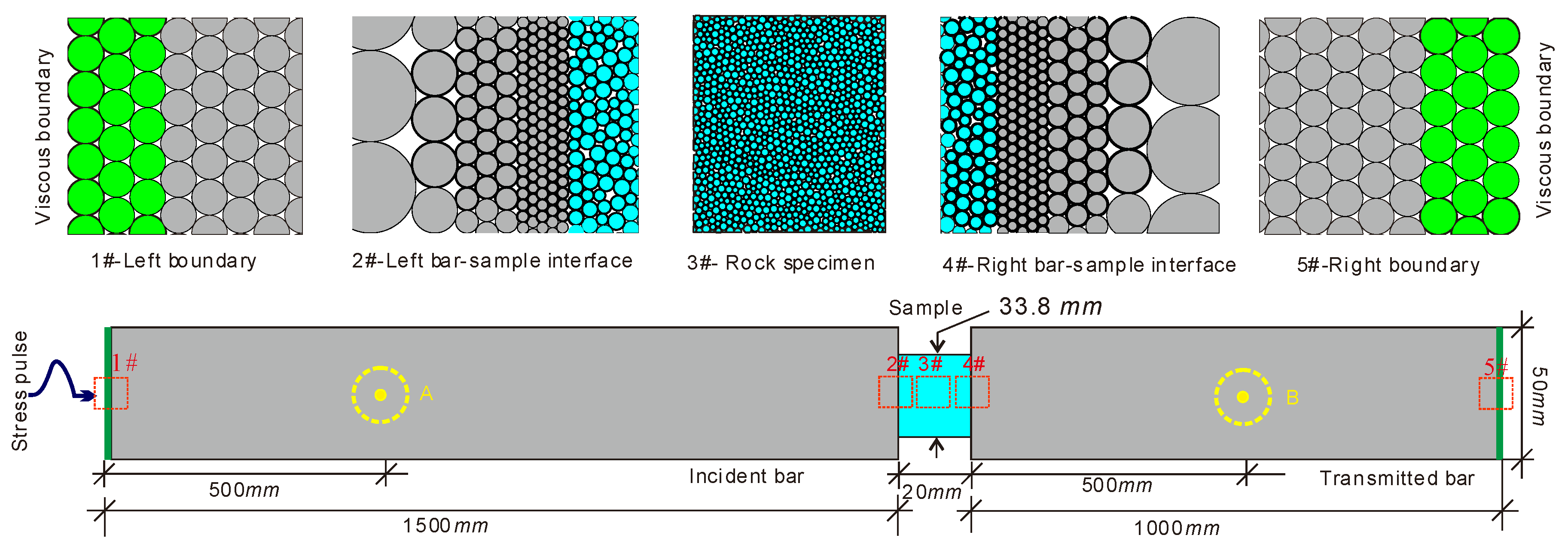
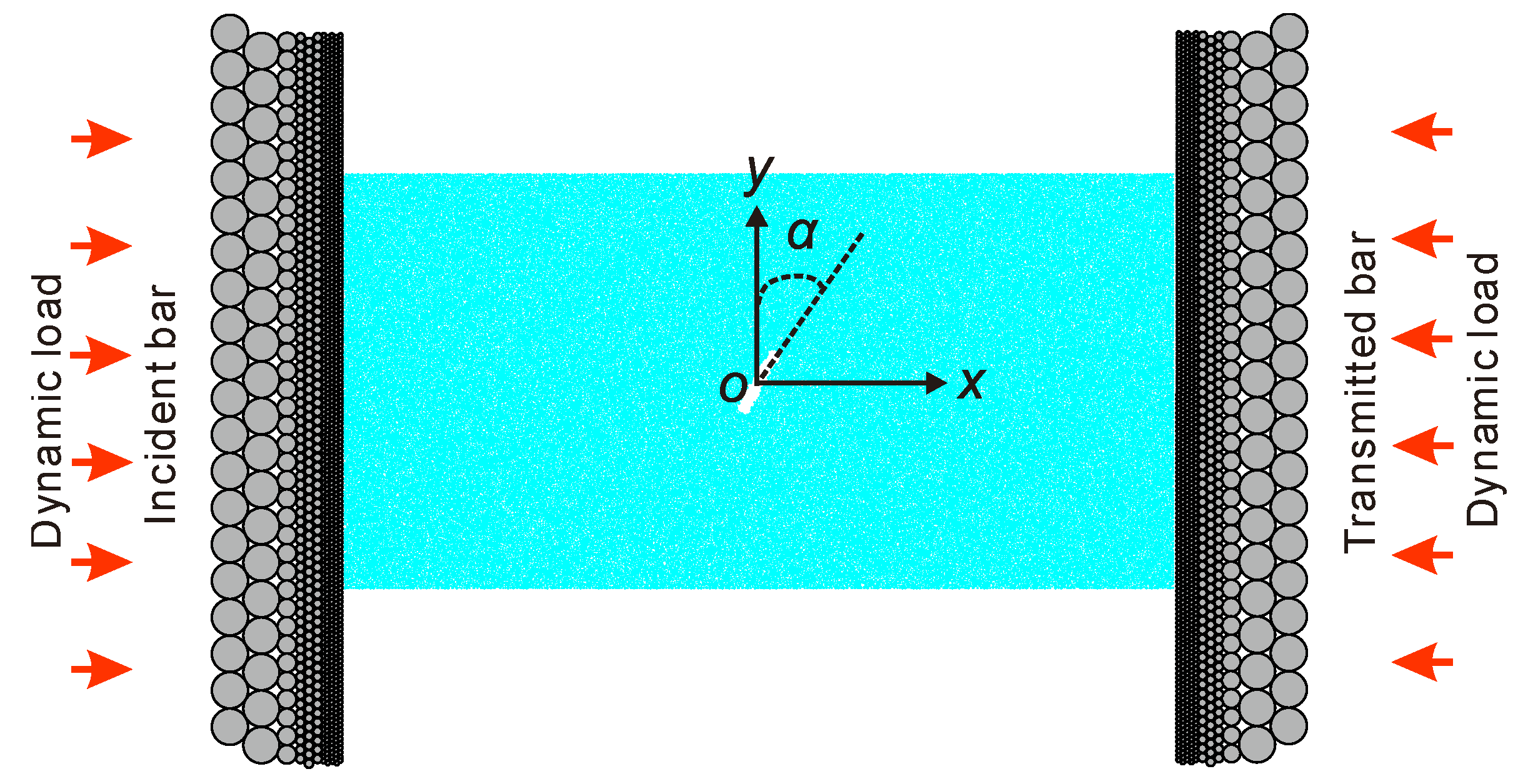
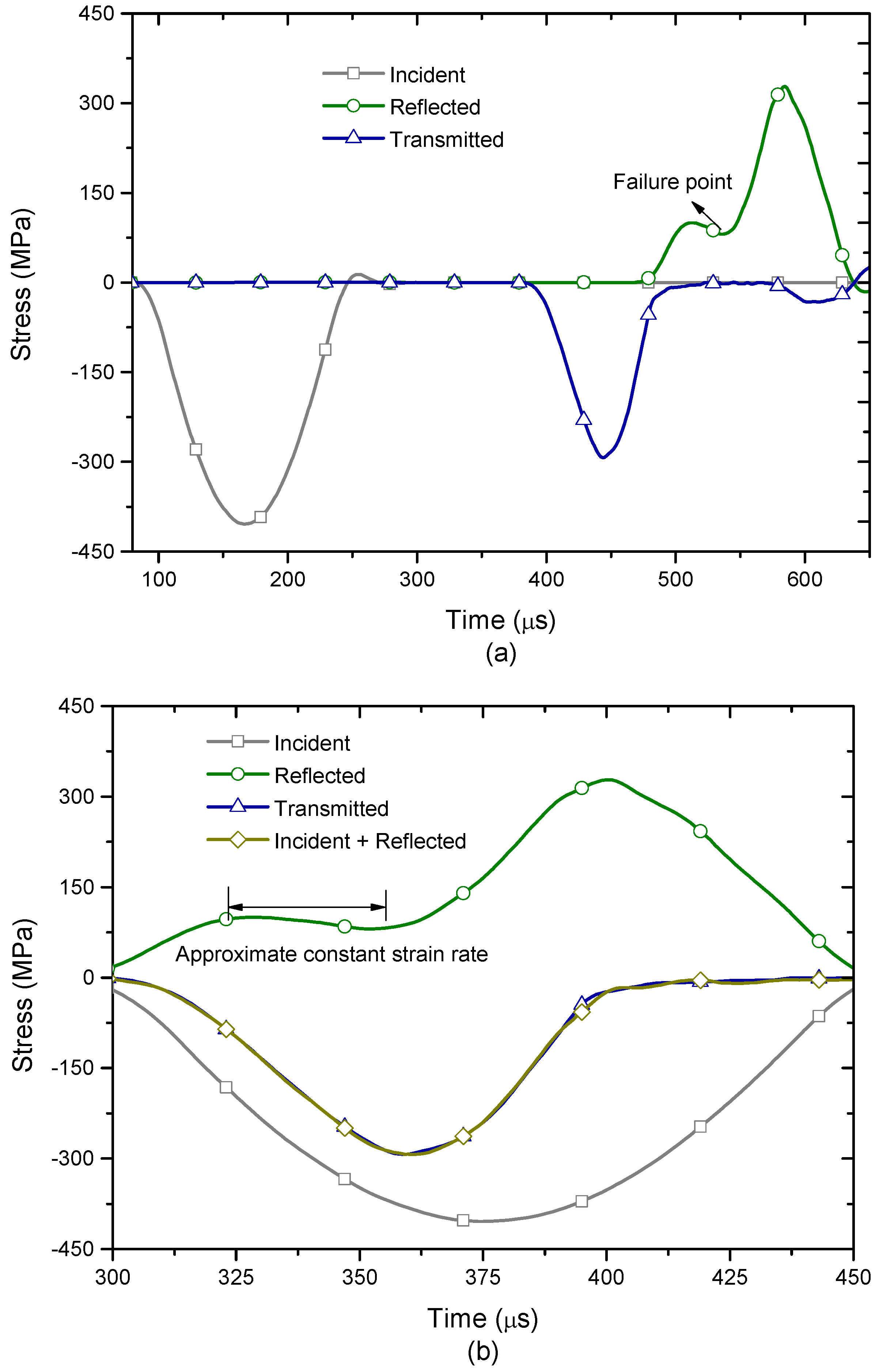
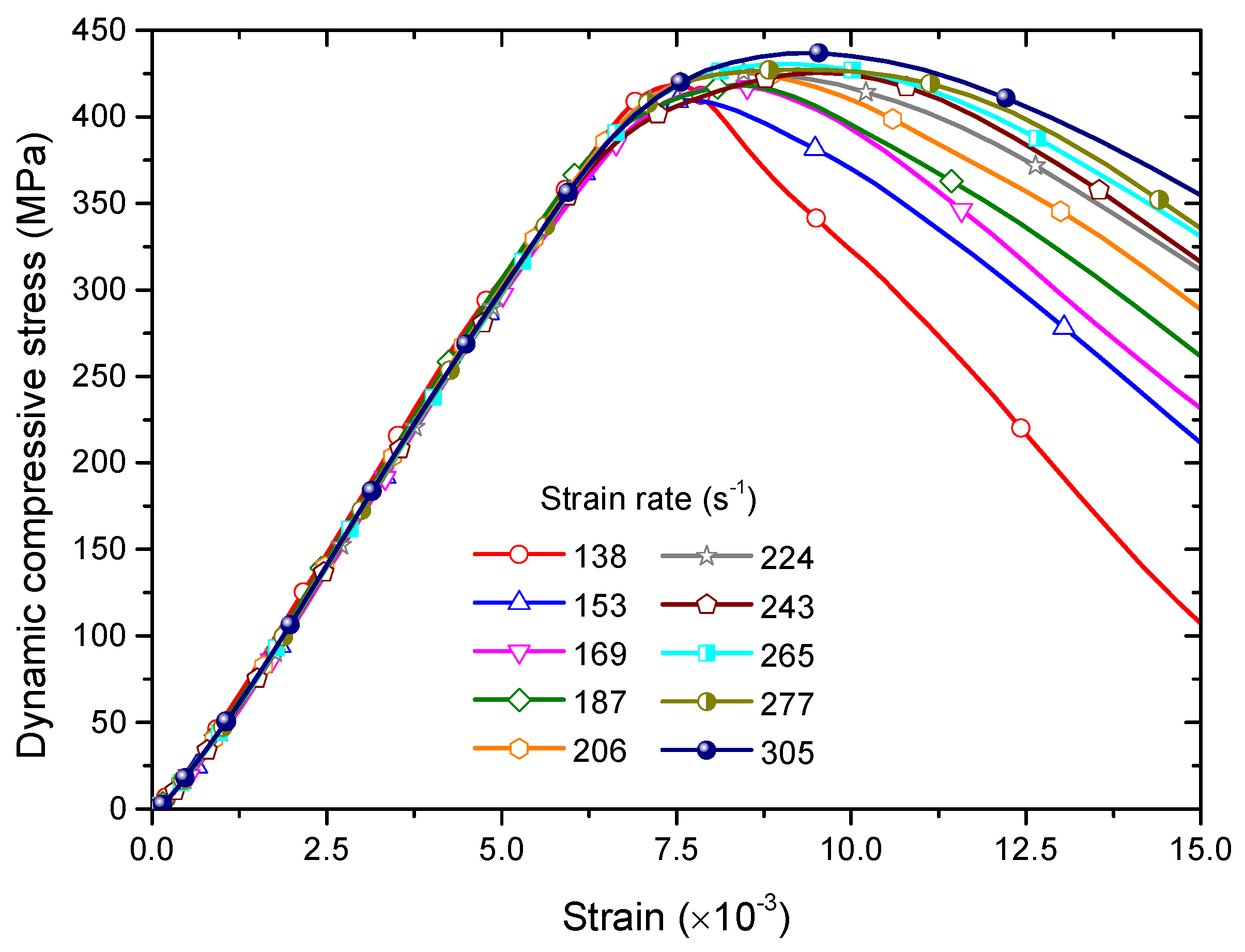
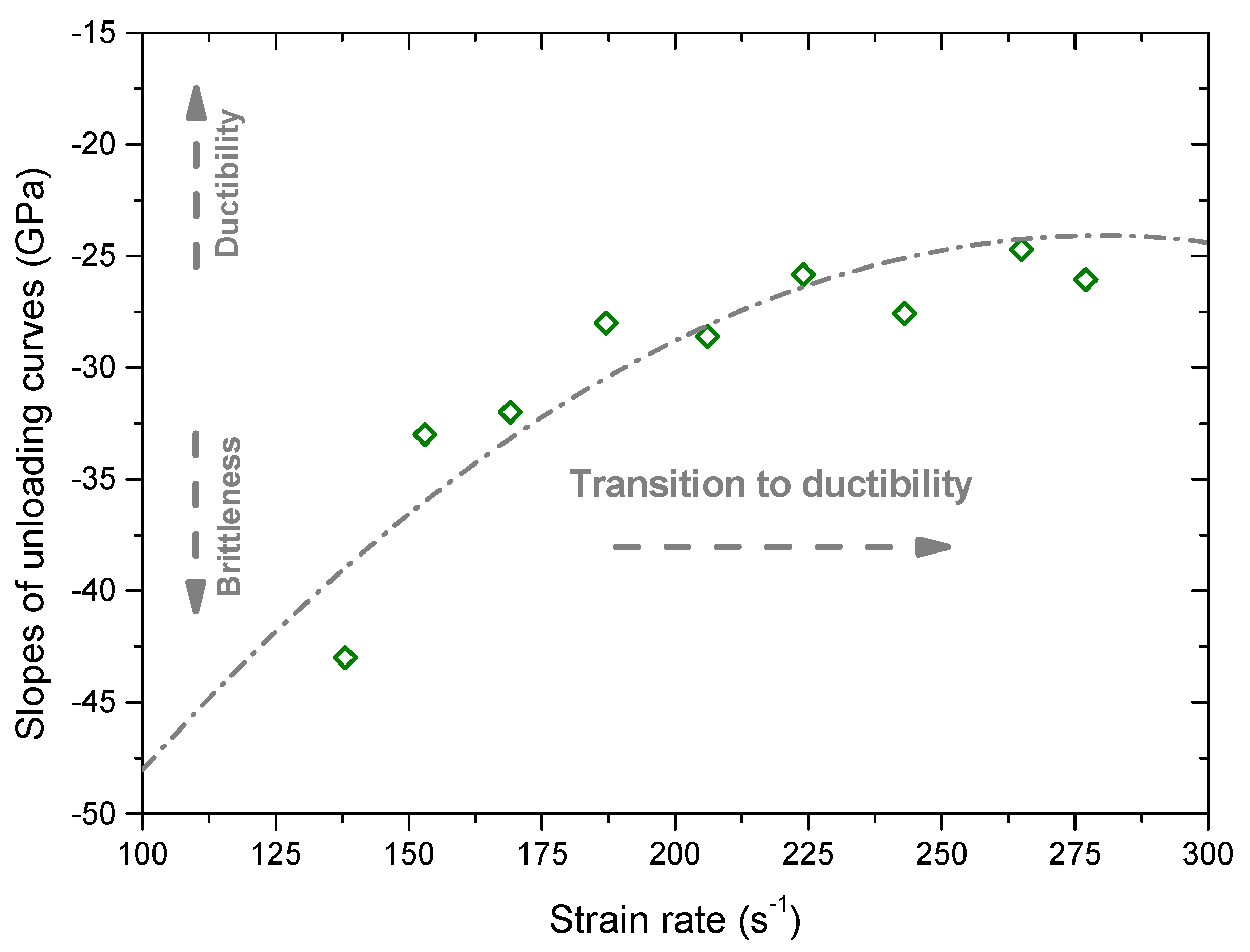
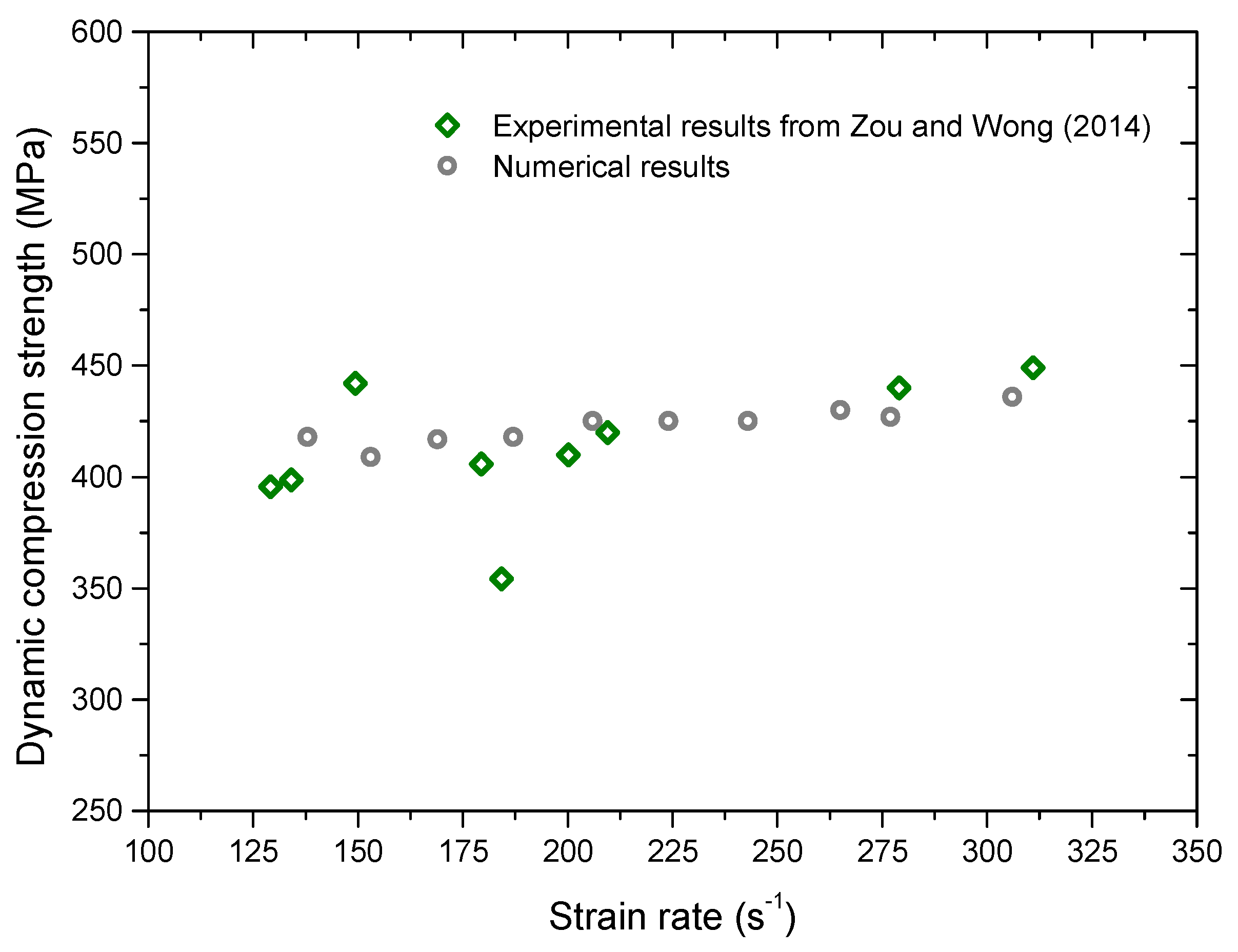
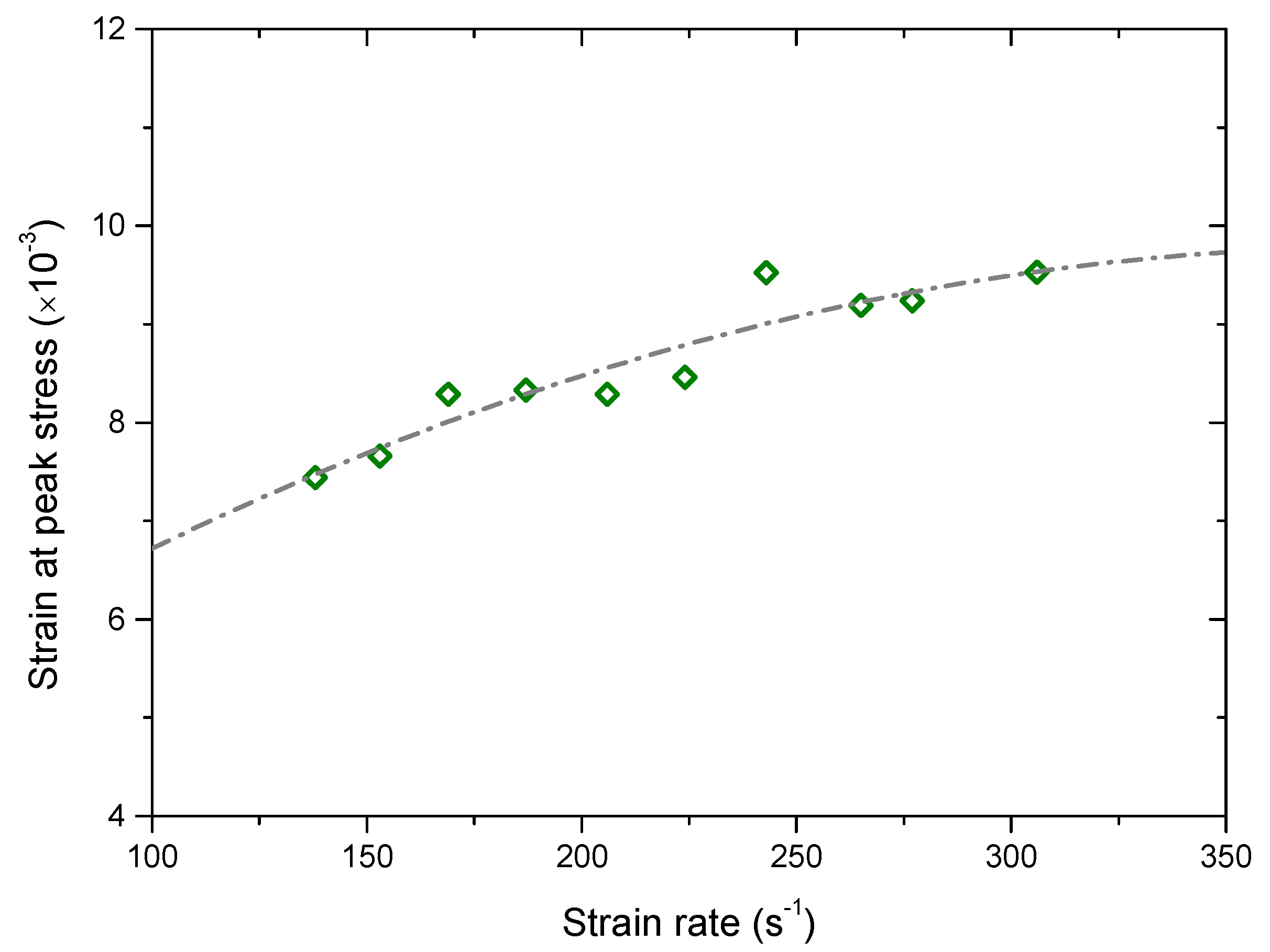

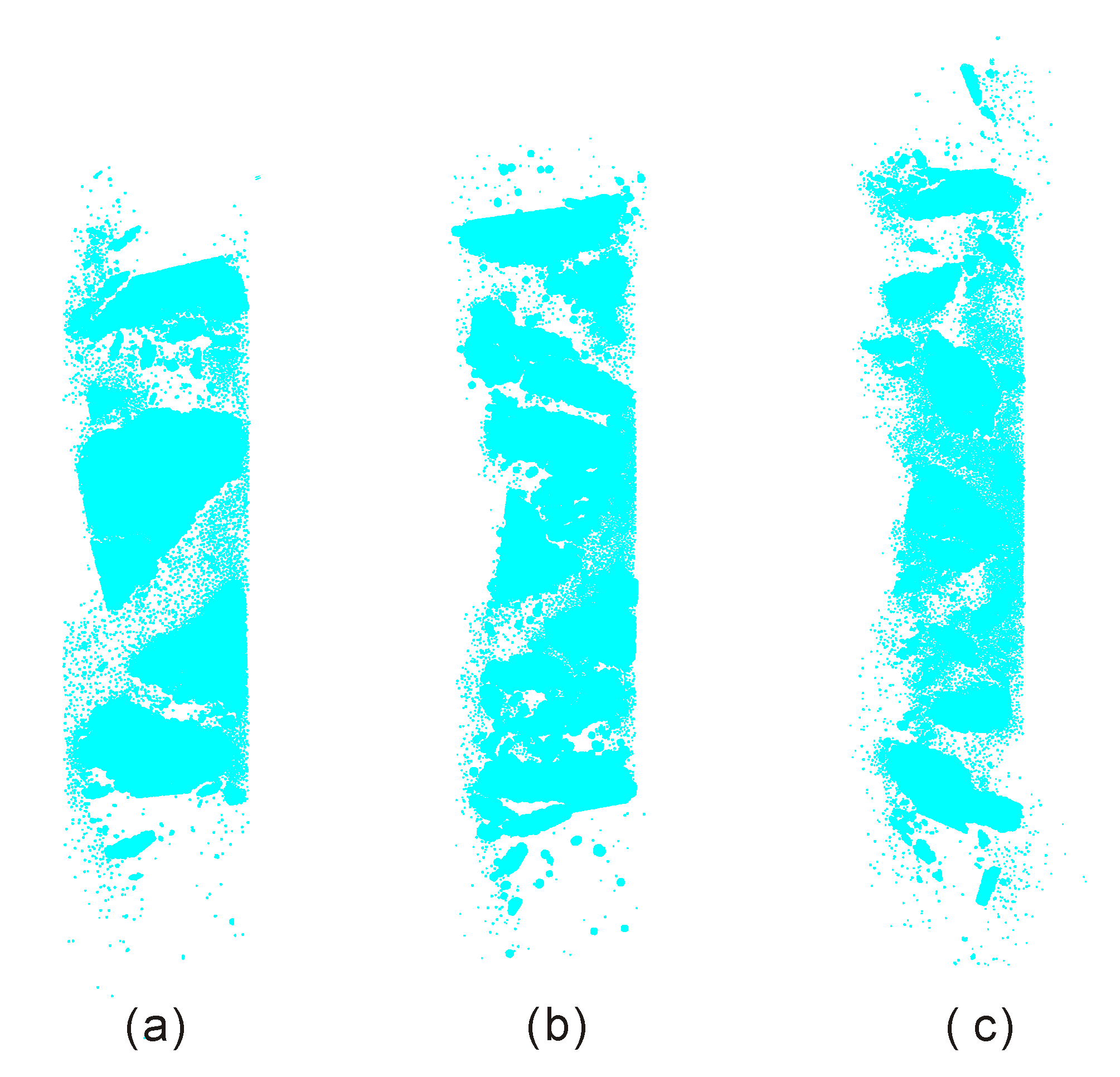

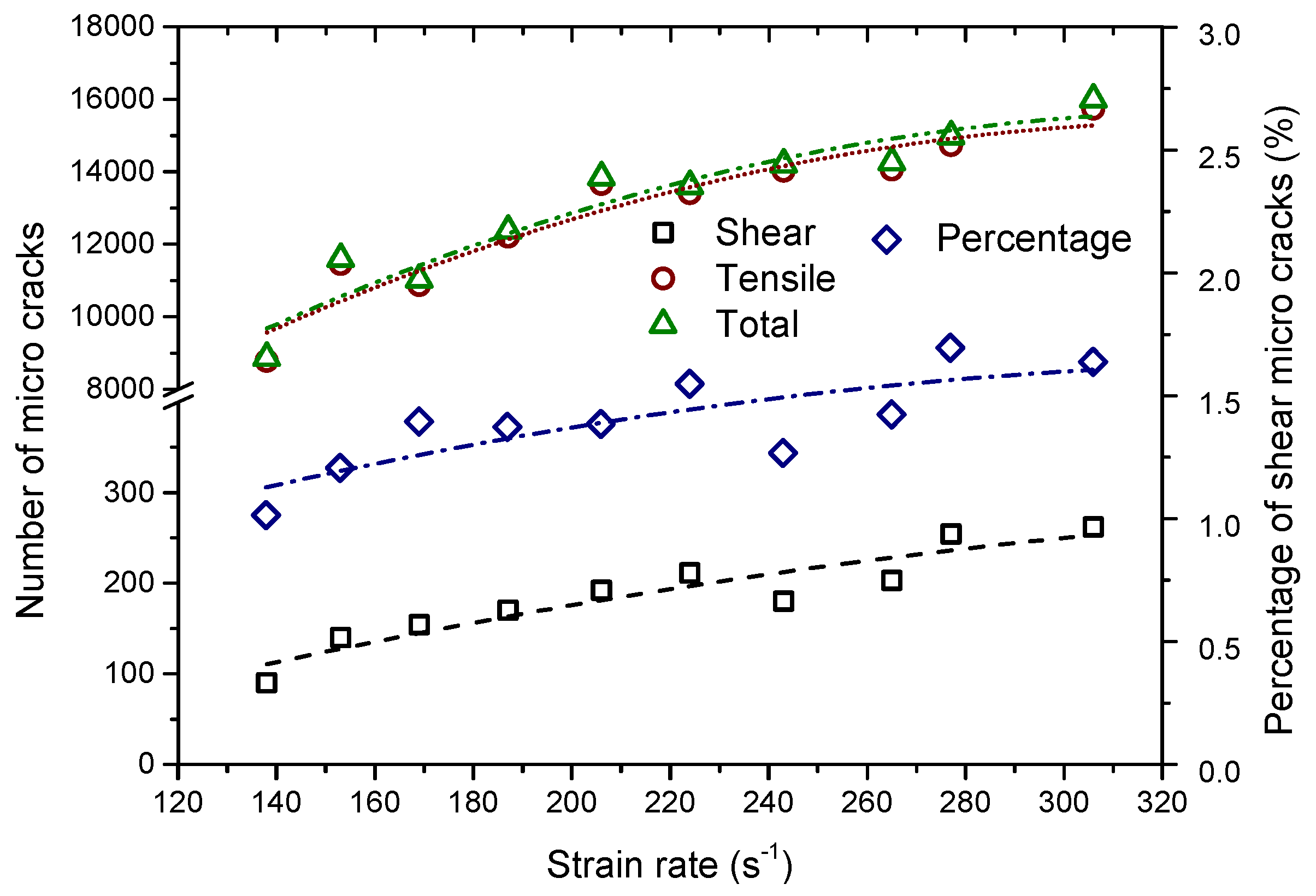


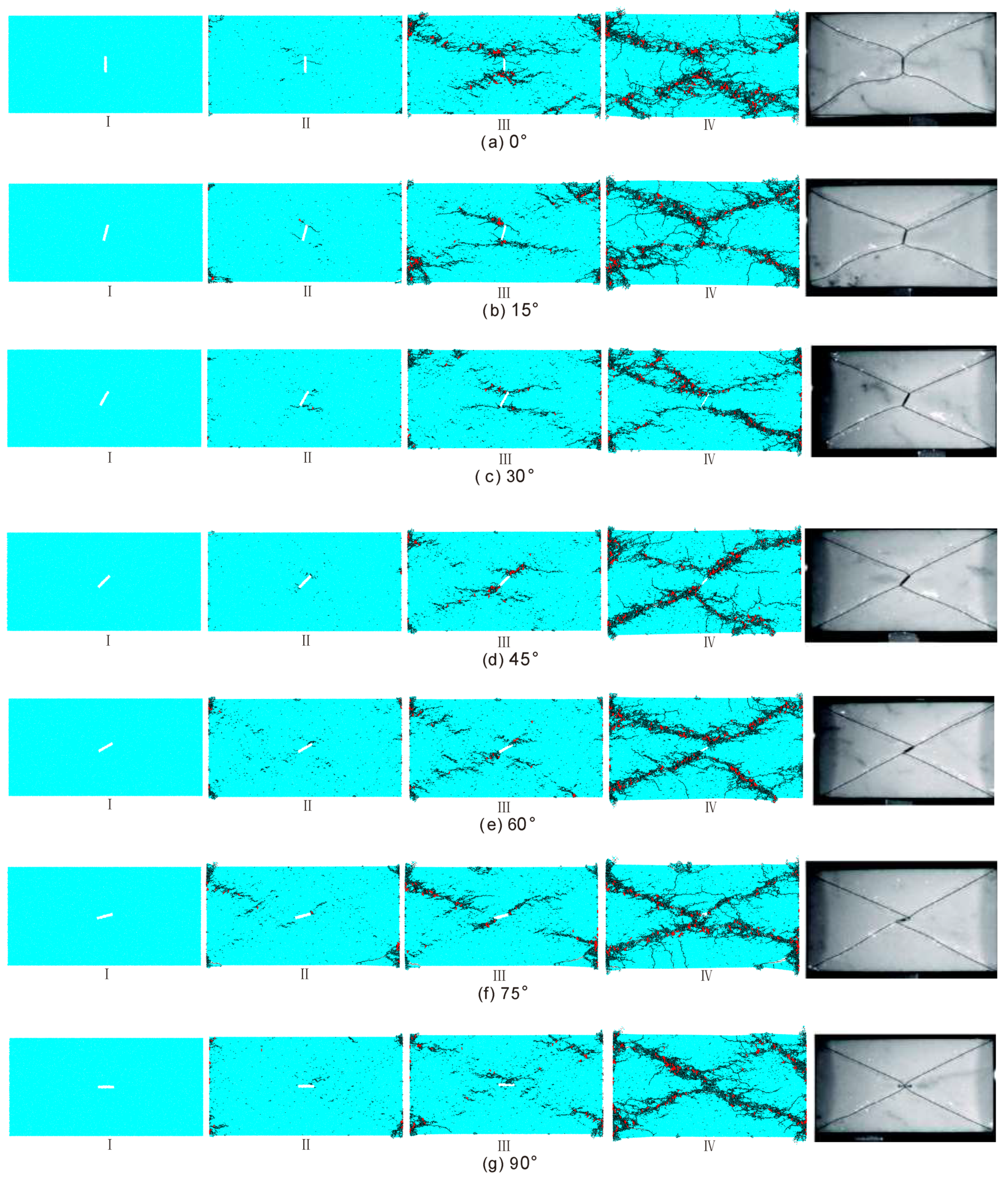

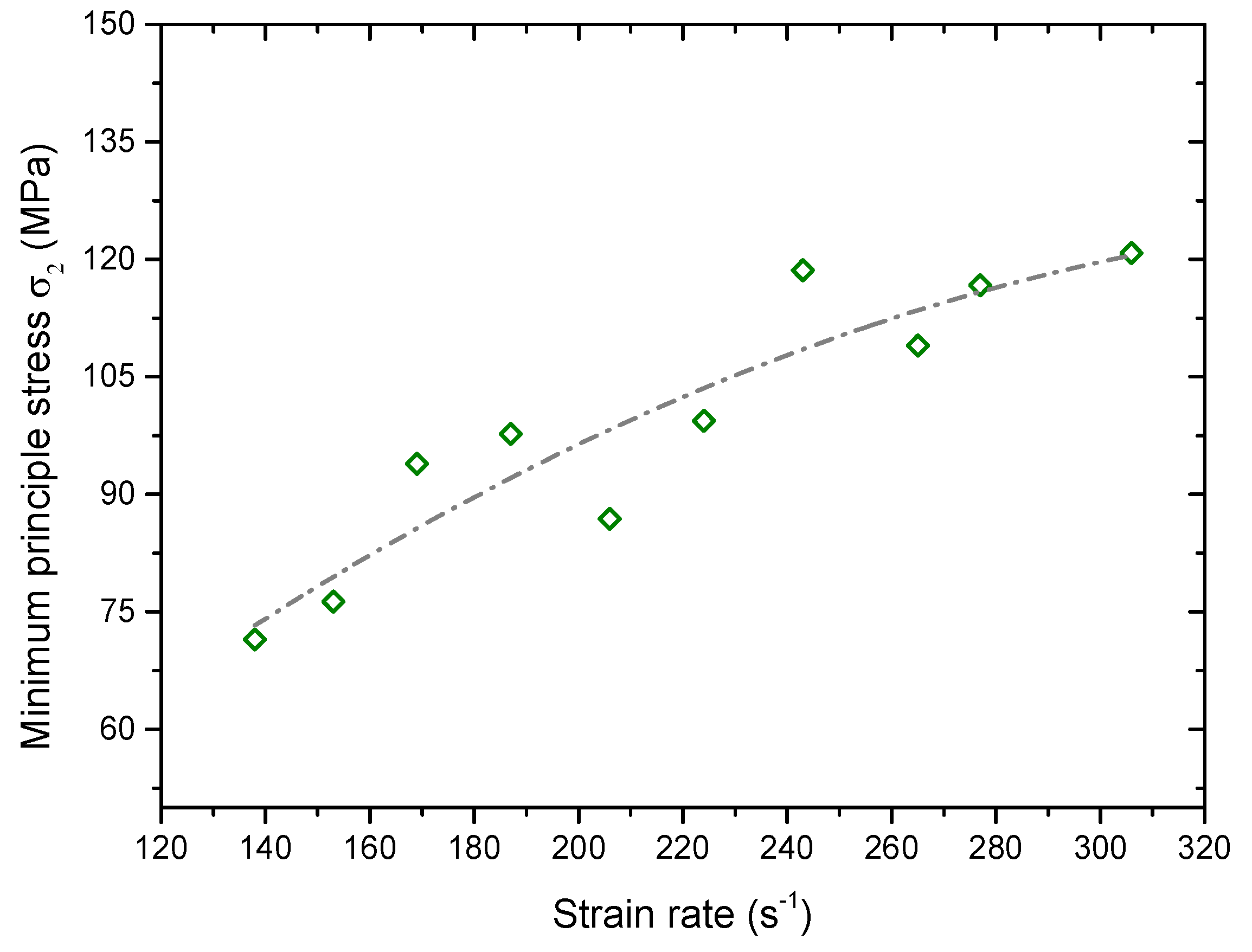


| Particle Parameters | Parallel Bond Parameters | ||
|---|---|---|---|
| Contact Young’s modulus () (GPa) | 206 | Young’s modulus of the parallel bond () (GPa) | 206 |
| Ratio of normal to shear contact stiffness () | 2 | Ratio of normal to shear stiffness of the parallel bond () | 2 |
| Contact friction coefficient () | 0.8 | Tensile strength of the parallel bond () (MPa) | 108 |
| Ratio of maximum to minimum particle radius (Rmax/Rmin) | 1 | Shear strength of the parallel bond () (MPa) | 108 |
| Minimum particle radius (Rmin) (mm) | 2 | Radius multiplier () | 1 |
| Particle density (ρ) (kg/m3) | 8804 | ||
| Physical Properties | Steel | BPM |
|---|---|---|
| Density ρ (kg/m3) | 7894 | 7894 (continuum-equivalent) |
| Longitude wave velocity C (m/s) | 5048 | 5053 |
| Particle Parameters | Parallel Bond Parameters | ||
|---|---|---|---|
| Contact Young’s modulus () (GPa) | 60 | Young’s modulus of the parallel bond () (GPa) | 60 |
| Ratio of normal to shear contact stiffness () | 1.8 | Ratio of normal to shear stiffness of the parallel bond () | 1.8 |
| Contact friction coefficient () | 0.8 | Tensile strength of the parallel bond () (MPa) | 350 ± 80 |
| Ratio of maximum to minimum particle radius (Rmax/Rmin) | 1.6 | Shear strength of the parallel bond () (MPa) | 550 ± 80 |
| Minimum particle radius (Rmin) (mm) | 0.08 | Radius multiplier () | 1.0 |
| Particle density (ρ) (kg/m3) | 3228 | ||
© 2020 by the authors. Licensee MDPI, Basel, Switzerland. This article is an open access article distributed under the terms and conditions of the Creative Commons Attribution (CC BY) license (http://creativecommons.org/licenses/by/4.0/).
Share and Cite
Huang, X.; Qi, S.; Zheng, B.; Guo, S.; Liang, N.; Zhan, Z. Progressive Failure Characteristics of Brittle Rock under High-Strain-Rate Compression Using the Bonded Particle Model. Materials 2020, 13, 3943. https://doi.org/10.3390/ma13183943
Huang X, Qi S, Zheng B, Guo S, Liang N, Zhan Z. Progressive Failure Characteristics of Brittle Rock under High-Strain-Rate Compression Using the Bonded Particle Model. Materials. 2020; 13(18):3943. https://doi.org/10.3390/ma13183943
Chicago/Turabian StyleHuang, Xiaolin, Shengwen Qi, Bowen Zheng, Songfeng Guo, Ning Liang, and Zhifa Zhan. 2020. "Progressive Failure Characteristics of Brittle Rock under High-Strain-Rate Compression Using the Bonded Particle Model" Materials 13, no. 18: 3943. https://doi.org/10.3390/ma13183943





